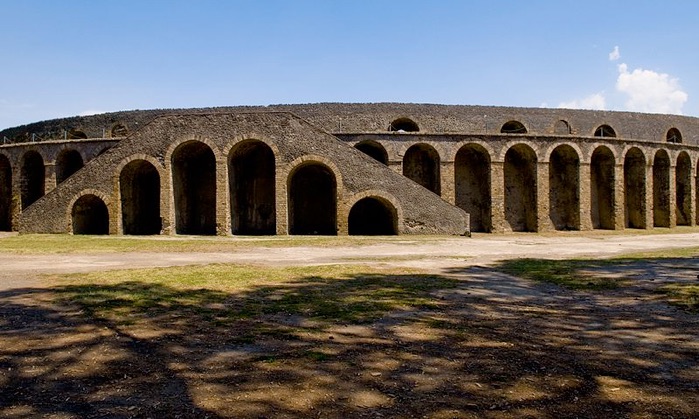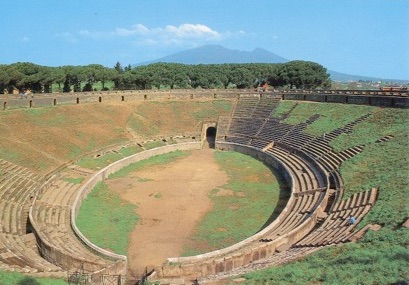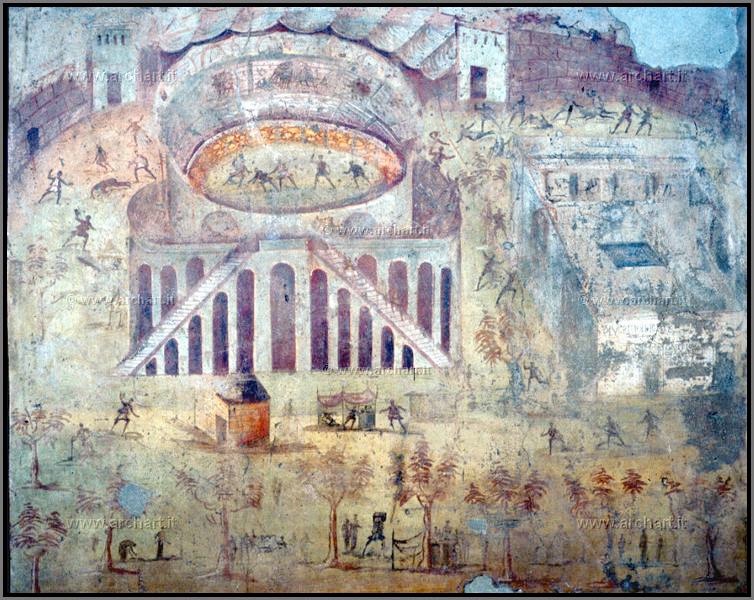Archaeological tours, packages and exclusive multy day excursions in Campania for tourists, lovers,
scholars and students.





Archaeological tours, packages and exclusive multy day excursions in Campania for tourists, lovers,
scholars and students.
"Caius Quinctius Valgus son of Caius and Marcus Porcius son of Marcus, as the mayors of fifth year, for expression of honor for the colony, had built at his own expense the building for the shows, and donate it to the citizens of the colony in perpetuity" this inscription on a travertine slab at the entrance of the amphitheater of Pompeii, testifies the year of construction (about 80 BC) and indicates the amphitheater as the oldest building for shows come to us in good condition. The term amphitheater has Greek origin and it is indicated for the first time by Vitruvius. It has an elliptical structure consisting in an arena where the games took place, and around it stands dedicated to the public.
The building was constructed in the recently urbanized south-east of the city, placing it against the city walls whose embankment was holding the southern and eastern stands. The northern and western walls of the structure were held, however, by buttresses with blind arches, with the exception of the two major corridors leading to the arena that were often occupied by street vendors, as well as results from some inscriptions. In Pompeii, the amphitheater was defined spectacula, and it was a meeting place, recreation and often political or commercial negotiations. The building could accommodate up to 20.000 spectators. The stands (caveae), built later, were divided into three sectors, and were made of volcanic stone. The ima cavea (front row) for aristocrat citizens, the media and the summa for all the others, had higher independent tunnels of access (crypta) built to ensure an ordained influx of the public. The amphitheater was equipped with a velarium, a huge canape probably in linen, used to repair the spectators from the sun. A series of articulated beams inserted into rings of stone supported the velarium, whose presence was very appreciated, and reported in the written advertised the shows with the words "et vela erunt".

The entire structure of the amphitheatre was shown in a famous fresco, now at the Naples Archaeological Museum, documenting the fight between the Pompeians and Nucerians happened in 59 d. C, narrated by Tacitus in the Annals (XIV, 17 et seq.). The fight, which caused numerous deaths and injuries, is easily derived from discord between citizens born after the deduction of certain territories to the detriment of Pompeii. The gravity of this event caused the intervention of the then Emperor Nero, who imposed the closure of the amphitheatre for ten years, and punished the responsible with exile, but the punishment was cancelled after the earthquake of 62 AD when the structure, as an inscription tells us, was restored at the expense of Cuspius Caius Pansa.
The amphitheatre of Pompeii held above all to the fights between gladiators. The term gladiator comes from the short sword said gladium that the fighters used. The battles took place between pairs of gladiators (paria) equipped with different weapons, or between two teams (familiae) of gladiators. Among the major categories of gladiators were the traex, the retiarius, the secutor, the controretiarius, the Murmillo and the samnes; they were slaves and criminals who were trying, in this way, to redeem themselves. The training took place in gyms and specific schools through the hardest workouts, the fatigue and the risk from typhus were rewarded by the admiration of the crowd, especially the women’s one, as documented by a lot of graffiti in their honour.



Anphitheater in Pompeii
fresco that testifies the fight between Pompeii and Nocera in 59 B. C.
AMPHITHEATER OF POMPEII
Pompeii Tour guide - Herculaneum Tour guide - Stabiae Tour guide - Oplontis Tour guide - Naples Tour guide
Amalfi Coast - Sorrento - Positano - Paestum Tour guide - Capua Amphitheater - Procida - Ischia - Capri
Copyright © Pompeiin.com - E-mail: info@pompeiin.com

